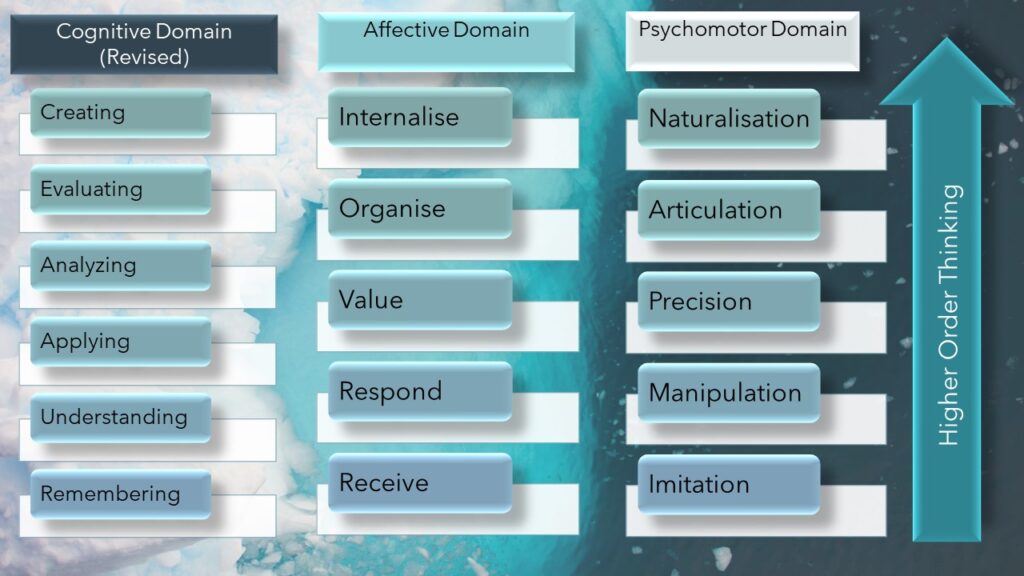
Education is the movement from darkness to light.
— Allan Bloom
I recently reviewed a training program. Not really blog worthy, right? Well, it so happened that this training program was riddled with the types of objective statements that really get my hackles up. You may know these types of objectives – the ‘understanding’ objectives, or even worse ‘good understanding’… As in:
‘The student will demonstrate an understanding of…’
I always look at this and say, well, how does one demonstrate ‘understanding’? What is ‘understanding’ anyway? As an adjective, it is to be ‘sympathetically aware of other people’s feelings…’ as a noun it refers to ‘comprehension’ I love one definition I found: ‘the capacity to apprehend general relations of particulars’
OK, yeah, I can assess that easily… not!
This can then be coupled with ‘a good understanding of…’
I think of good a bit like beauty – in the eye of the beholder. Pretty hard for different people to look at the training and assess a ‘good understanding of…’
So, why do we need to rid the world of ambiguous and subjective training objectives? Let’s look at it from a more ‘management’ point of view.
Peter Drucker is often quoted as saying “you can’t manage what you can’t measure” and this goes on to “if you can’t measure it, you can’t improve it“
So, if we don’t have clearly defined and consistent objectives how can we ever realise the true value of education? The ability to provide that light that Allan Bloom was talking about?
We need to ensure we create effective training objectives that consider the three ‘domains’ of learning – cognition (knowing / knowledge); psychomotor (physical / skills) and affective (emotions / attitude). If this looks like the standard ‘KSA’ (Knowledge, Skills and Attitudes) that we refer to in training, that’s because it is!

In 1956 Benjamin Bloom created a taxonomy, or a classification system, to support learning objectives in the cognitive domain. Other notable names in the development of training objective taxonomies include Krathwohl, Dave and Anderson (and I’m sure there are more…) Over the years others have addressed affective and psychomotor domains, and the ‘revised’ version of the taxonomy came out in 2001 after much deliberation. The main ‘headings’ go from the simpler levels to the more complex level, addressing the concept of the ‘Higher Order of Thinking’ (or ‘HOT’).
Great, here are some broad headings that could support developing objectives. Now what? To support each of these ‘headings’ the taxonomies provide specific verbs. These can help us write effective, and meaningful objectives. For example, at the ‘remembering’ level verbs such as arrange, define, list, name, and recite all work. Then, at the ‘understanding’ level (remember my pet peeve about ‘a good understanding of…’) verbs that can be used when writing objectives include interpret, summarize, explain, and discuss. Similarly, for the HOT of ‘creating’ you can use verbs such as design, build, construct, plan, and invent. Check out the taxonomies online, there are multiple sites that provide all these and more!
This gives us a great set of building blocks to create our objectives. Next, we need to consider what to include. A solid objective includes three key elements – a condition (the ‘how’), a performance (the ‘what’), and a standard (the ‘how well’). For example, using the lowest order of thinking (remembering):
- Based on the (accidental) virtual trainer’s blog (condition)
- list the three training domains and their levels (performance)
- to an accuracy of 100% (standard).
Finally, for every objective you develop you should put it through the SMART objectives filter – Specific, Measurable, Achievable, Realistic and Timely/time-bound.
For the sample objective, it may meet all but the ‘achievable’ element – after all, no one is perfect… So let’s revise it to read:
Based on the (accidental) virtual trainer’s blog, list the three training domains and their levels to an accuracy of 80%.
Training is all about moving from darkness to light – sharing knowledge, evolving, growing and improving. To improve we need to know where we are going, how we are going to get there, and how we will know we have arrived. Training objectives provide us with the road map, so we can move together towards a known goal, address the challenges along the way and then celebrate the wins.
Next – back to making online learning STICK – a focus on ‘T’ – Technology.
Jillian Carson-Jackson, M.Ed., FRIN, FNI
31 December 2021

